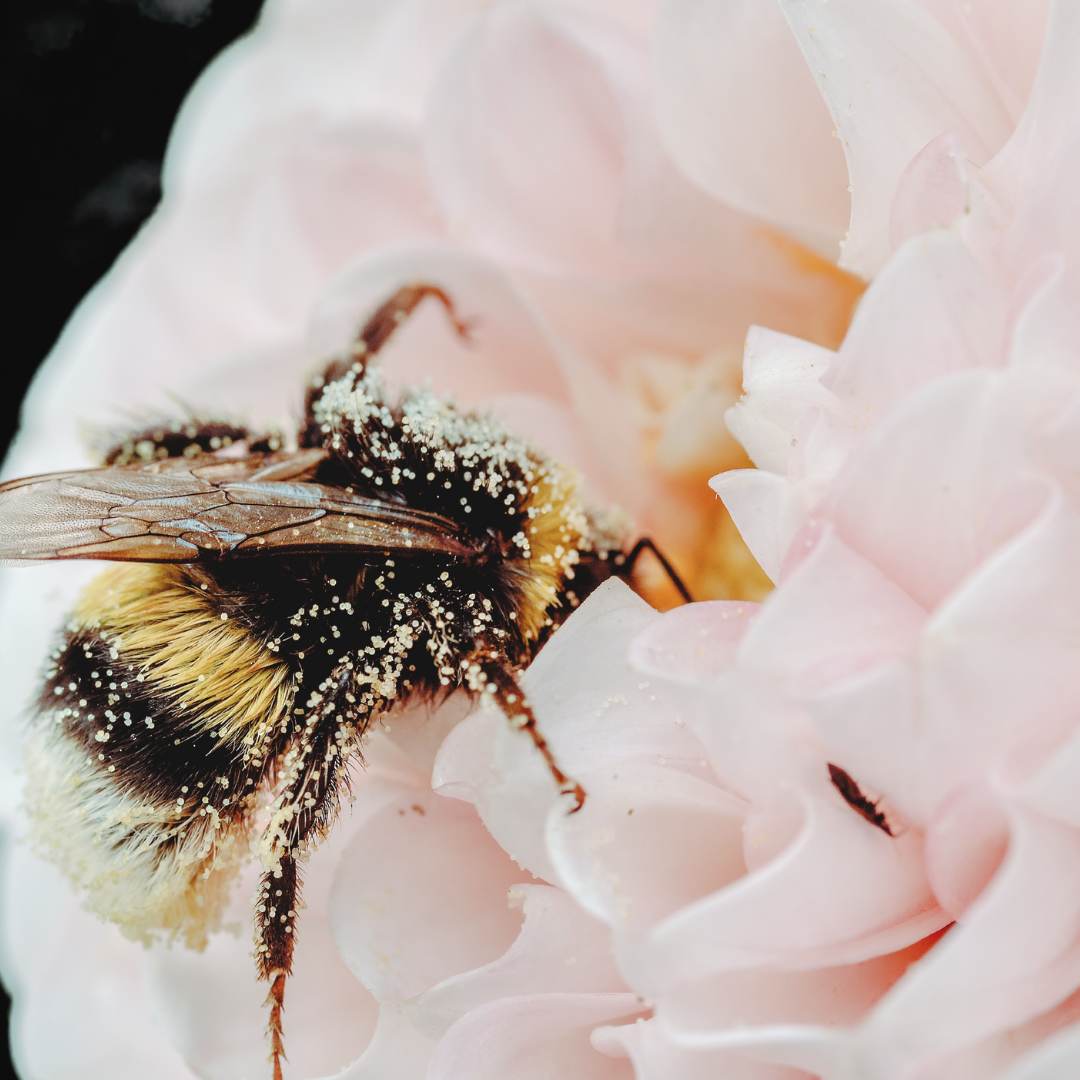Right now, the bees need us as much as we need them. Both wild bee populations and honeybees have suffered staggering population loss over the past 50 years. The issues surrounding bees are so complex that one cannot simply be anti- bee products. Otherwise we would also have to refuse to eat blueberries, almonds, cranberries, tomatoes... nearly 20-30% of our food supply is made by bees.
While beeswax isn't vegan (unlike all of the other ingredients we use, which are vegan), we believe that beekeeping, when performed responsibly, is integral to the health of our global food supply and represents an important avenue of environmental stewardship, conservation, and an opportunity to understand and help other native pollinators.
Farm To Table from Andrea Wing on Vimeo.
By including beeswax in our products, we aim to help to raise awareness about the incredible role bees play in our world and the challenges they face. We want vegans to understand that boycotting bee products altogether can create a greater threat to bees, and that there are other strategies that can be implemented (such as choosing organic, avoiding the use of pesticides and herbicides, joining your local beekeepers' association, planting bee- and pollinator friendly gardens, buying local and sustainably harvested honey) that can do more for bees than avoiding their products altogether. You can also become a beekeeper yourself, but first make sure you learn as much as you possibly can, and that you are prepared for all of the work, responsibility, time and financial investment that are required to properly care for animals.
Beekeepers are on the frontline of the bee colony loss crises, and are taking extra measures to ensure that in spite of annual 40% colony losses, net bee populations are actually now increasing by 1% annually since the population loss concerns were recognized.
"The Pollinators," 2019 Documentary (watch below) is a cinematic journey around the United States following migratory beekeepers and their truckloads of honey bees as they pollinate the flowers that become the fruits, nuts and vegetables we all eat.

The Pollinators from Demand Film on Vimeo.
How you can help the bees:
Plant bee friendly flowers
Bees are losing habitat as the world becomes more developed, but this is easily remedied by planting flowers for them to forage in your garden. Planting large amounts of the same blooms together can be especially helpful, as bees love the volume.
Wondering which flowers are best suited for your garden? This link provides a great list of plants which are popular with bees.
Eat organic
Many inorganic food crops are grown using pesticides suspected to harm bees, such as neonicotinoid and systemic pesticides. Try growing your own fruits and vegetables at home; this makes eating organic a much more affordable option. And if growing your own produce isn't for you, eating organically grown produce ensures that you aren't supporting the use of harmful pesticides. If you only select a few organic items at the grocery store, choose those that are pollinated by bees and other pollinators. Some examples of these include apples, pears, courgettes, tomatoes, berries, and almonds.
The Whistler Farmers' Market runs May - Oct. and is great place to find fresh, local, organically grown produce and honey.
Try using natural methods of pest control
Although there is no one cause of the decline of bee populations, it is suspected that the widespread use of pesticides, herbicides, and fertilizers is largely responsible. Instead of using these chemicals in your own garden, try using some natural methods of pest control. In addition to being better for environment, using natural methods can help save you money. One of the easiest ways to reduce the amount of pests in your garden is to have birdhouses. This is a great way to use nature to control pests naturally, as they provide nesting grounds for birds which will then feed on garden pests.
Eat local honey
By eating local honey you can help support local farmers, and help beekepers cover their costs. Beekeepers and farmers often work hand in hand as both sides depend on the health of bees. Agricultural land provides a much needed source of food for honeybees, and in return, bees pollinate crops and help farmers produce a more bountiful harvest. Bubbee's Farm in Pemberton is a great example of this, as they manage four beehives which they use to pollinate their crops. They also extract and sell their raw honey to the public in the fall. The Fairmont Chateau Whistler manages four hives whose bees pollinate local flowers and produce honey that is used by the hotel's chefs. You can read more about the Fairmont's 'Bee Sustainable' program here. Consuming raw honey, as opposed to processed, ensures that you reap the many health benefits that honey provides. These include its antibacterial and antifungal properties, in addition to being a great source of antioxidants.
Help to preserve habitat for native bees and other pollinators!
Becoming a conservationist is one of the most important things you can do to help domestic and wild bees. Habitat loss is a major threat to pollinators. We need to conserve natural areas to help save bees.
Bees like water too!
Do you already have a garden full of flowers which is attracting a lot of bees? Do them a favor and leave out a dish of water to drink from. Bees don't like to get their feet wet as they collect water, so a shallow dish filled with water and some small rocks for them to perch on is ideal.
Raise awareness
Finally, one of the most important things you can do to help save the bees is to spread the word. If you don't have the means to plant your own garden, maybe you have a friend or family member who does. Encourage others to do their part, and together we will be able to make a difference, and hopefully save the bees!
For additional information on how we can stop their numbers declining, please visit this guide.

How CUTE is this bee?: https://www.instagram.com/p/B5V2G1lB5PI/
Our products are cruelty free and not tested on animals. The foundation of our products is plant-based and vegan, with select products containing organic, sustainably harvested Canadian beeswax.
But is Beeswax vegan? No, beeswax is technically not vegan, since bees are little animals, and there are definitely animal welfare concerns to be addressed and poor husbandry practices to be found in the beekeeping industry. Because commercial honeybees are such an important part of our agricultural system, they are moved from one crop to the next. This means that their hives are stacked onto semi- trailers and moved across the country. Also, colonies that have developed disease that poses a threat to other bee populations may be culled (intentionally killed), and often this is not performed humanely. Honeybees have been facing significant challenges in the past decade, with colony decline rates so high that beekeepers must actively replace queens and split hives to ensure that bee populations populations do not become critically endangered. The process of artificially reproducing bees is not generally considered to be humane. Irresponsible beekeepers (often backyard beekeepers that have insufficient training) may contribute to the perpetuation of infectious diseases (like the Varroa mite and the viruses associated with it) in local bee populations through poor husbandry practices. When honey and beeswax are over-harvested, bees may not have sufficient nutrients to survive the winter. Beeswax also helps to provide bees with immunity.
Wild native bees, like bumble bees, are also facing severe population declines, with many on the brink of extinction. Because honeybees play such an important role in our food supply, they are more closely monitored than wild native bee populations. The dangers facing honeybees also face wild bees, but the sad part is that wild bee populations aren't receiving as much help as honeybees are, and so many are becoming extinct. Habitat loss, infection, climate change, and exposure to toxins (such as pesticides and herbicides) are believed to be playing a major role, and because these are human activities, there is a lot we can do to help.
When done properly, beekeeping is about stewardship and cooperation- so that we can grow food. Because honey bees are the backbone of our agricultural system, they are monitored closely by government organizations, and serve as an indicator species for challenges facing other pollinators (such as indigenous bee populations like bumble bees and butterflies). Beekeepers are the people on the front lines of the crisis, helping us to learn more about why bees are dying and working extra hard to ensure that in spite of annual 40% colony losses, net bee populations are actually now increasing by 1% annually since the population loss concerns were recognized.
Chatting Bee Medicine With The Bee Veterinarian | Twin Trees Vet Talk
What's Killing the Bees? from HarvardCCHANGE on Vimeo.
Vanishing of the Bees is a 2009 documentary film by Hive Mentality Films & Hipfuel Films, directed by George Langworthy and Maryam Henein and released in the United Kingdom in October 2009. The story is centered on the sudden disappearance of honey bees from beehives around the world, caused by the poorly understood phenomenon known as Colony Collapse Disorder or CCD. Although the film does not draw any firm scientific conclusions as to the precise cause or causes of CCD, it does suggest a link between neonicotinoid pesticides and CCD.[1][2]
Vanishing of the Bees from VANISHING OF THE BEES on Vimeo.

Vanishing of the Bees - Educational Cut - 34 Minutes from VANISHING OF THE BEES on Vimeo.
Beekeeping for Beginners:
Bee Resources Designed for Veterinarians:
Honey bee foraging and nutrition – biology, research and application. Ever wonder where honey bees go and how they decide what flowers to visit? In this HBVC – VETgirl webinar, Dr. Jennifer Tsuruda will discuss the biological basis of foraging behavior and the nutritional needs of honey bees. Professionals in this session will also learn how to apply this information to managed beekeeping practices.
What is killing honey bees and resources on honey bees and beekeeping Honey bees are frequently in the news with claims that bees are disappearing and annual losses are unsustainable. What is the truth behind these claims and what can veterinarians do about it? In this HBVC – VETgirl webinar, Dr. Jamie Ellis from the University of Florida will address these concerns by critically reviewing the loss rates of managed honey bees and outlining the primary stressors that impact colony health. In the second hour, Dr. Ellis will share his favorite resources to address these stressors. Veterinarians will leave the talk armed with tools and knowledge of where to get answers when faced with these issues in the field.
Honey Bee Veterinary Medicine: The Basics: In this VETgirl online webinar, Jeffrey Applegate, Jr., DVM, DACZM will discuss the basics needed to understand honey bee veterinary medicine. Owing to the US Food and Drug Administration’s 2017 Veterinary Feed Directive (VFD) rule, honey bees are considered food-producing animals and similar rules apply as for food animals. In this lecture, he will review:
- The superorganism (aka the hive) and its caste members
- The veterinarian’s role in honey bee care including the Veterinary-Client-Patient-Relationship (VCPR)
- Antibiotic usage in bees
- The VFD
- A basic overview of common honey bee diseases & conditions (More in Part 2!).
Honey Bee Veterinary Medicine PART 2: Common Diseases and Conditions: In this VETgirl online veterinary honey bee Part II webinar, Jeffrey Applegate, Jr., DVM, DACZM will discuss common diseases, parasitic, and other non-infectious conditions that affect honey bees. A basic understanding of diseases and conditions beyond those that may require veterinary intervention will be necessary to develop a strong VCPR with apiarist clientele. Veterinarians are called upon to help with treatment of honey bees; this lecture will review etiological agents, diseases, and overall treatment and management.


0 comments